HOW TO CHECK IF GIVEN FOUR POINTS FORM A RECTANGLE
Subscribe to our ▶️ YouTube channel 🔴 for the latest videos, updates, and tips.
The following steps would be useful to check if four points form a rectangle.
Step 1 :
Draw a rectangle with the given four points.
Step 2 :
Find the lengths of all the four sides.
Step 3 :
Check whether the lengths of opposite sides are equal.
Step 4 :
Using the diagonal, divide the rectangle into two triangles and check whether one of the vertices has right angle using Pythagorean Theorem.
Example 1 :
Check whether the following four points form a rectangle.
A(-3, -3), B(4, -3), C(4, 2), D(-3, 2)
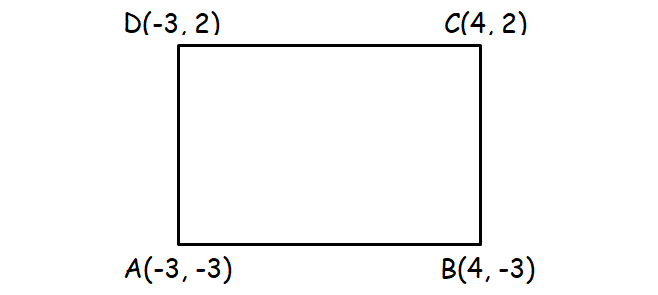
Solution :
Distance between A and B :
Formula to find the distance between two points :
d = √[(x2 - x1)2 + (y2 - y1)2]
Substitute (x1, y1) = A(-3, -3) and (x2, y2) = B(4, -3).
= √[(4 + 3)2 + (-3 + 3)2]
= √[72 + 0]
= √49
AB = 7 units
Distance between D and C :
= √[(x2 - x1)2 + (y2 - y1)2]
Substitute (x1, y1) = D(-3, 2) and (x2, y2) = C(4, 2).
= √[(4 + 3)2 + (2 - 2)2]
= √[72 + 0]
= √49
DC = 7 units
Distance between A and D :
= √[(x2 - x1)2 + (y2 - y1)2]
Substitute (x1, y1) = A(-3, -3) and (x2, y2) = D(-3, 2).
= √[(-3 + 3)2 + (2 + 3)2]
= √[0 + 52]
= √25
AD = 5 units
Distance between B and C :
= √[(x2 - x1)2 + (y2 - y1)2]
Substitute (x1, y1) = B(4, -3) and (x2, y2) = C(4, 2).
= √[(4 - 4)2 + (2 + 3)2]
= √[0 + 52]
= √25
BC = 5 units
From the above workings, AB = DC and AD = BC.
Opposite sides are equal.
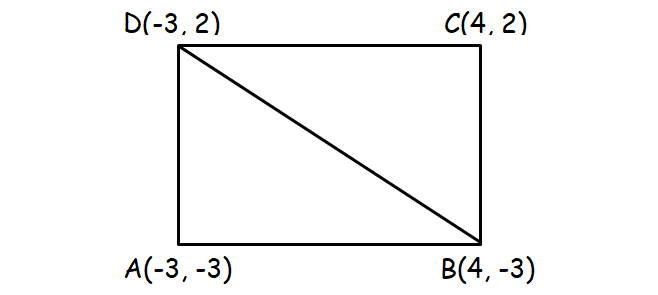
In the diagram above, consider ΔABC.
Distance between B and D :
= √[(x2 - x1)2 + (y2 - y1)2]
Substitute (x1, y1) = B(4, -3) and (x2, y2) = D(-3, 2).
= √[(-3 - 4)2 + (2 + 3)2]
= √[49 + 25]
BD = √74
BD2 = 74
AB = 7 ----> AB2 = 49
AD = 5 ----> AD2 = 25
49 + 25 = 74
AB2 + AD2 = BD2
ΔABC above satisfies Pythagorean Theorem, hence ΔABC is a right triangle with ∠A = 90°.
Opposite sides are equal and it is proved that one of the vertices has right angle.
So, the given four points form a rectangle.
Example 2 :
The rectangle LMNP has an area of 700 square units. The point L is (15, 15) and the point P is (−20, 15). Find one possible pair of answers for M and N
Solution :
Distance between L and P = √[(-20-15)2 + (15-15)2]
= √[(-35)2 + 0
= 35
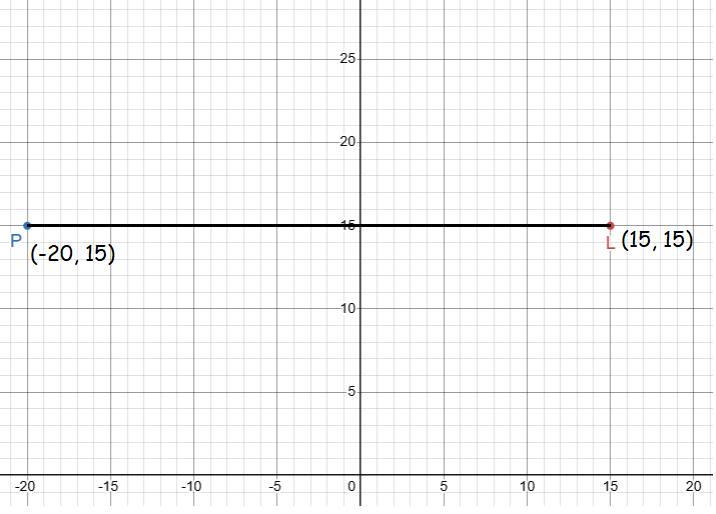
So, length of the rectangle is 35 units
Area of rectangle = 700 square units
length x width = 700
35 x width = 700
width = 700/35
width = 20 units
From y-coordinate of P, we have to move horizontally 20 units. So, we get the point 15 + 20 ==> 35 at this position.
M(-20, 35) and from -20, we have to move 35 units.
N(15, 35) is the required co-ordinate.
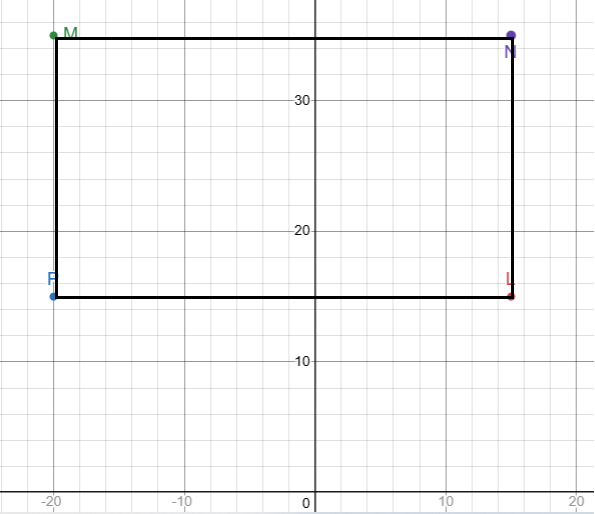
Example 3 :
Square LMNO is shown in the diagram below.
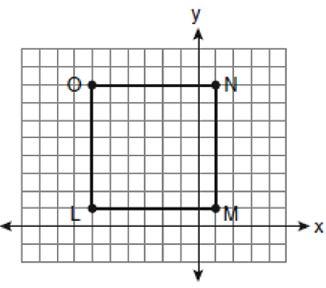
What are the coordinates of the midpoint of diagonal LN?
Solution :
The coordinates of L (-6, 1) O(-6, 8) N(1, 6) and M(1, 1)
Midpoint of the diagonal LN = (x1 + x2)/2, (y1 + y2)/2
= (-6 + 1)/2, (1 + 6)/2
= (-5/2, 7/2)
Example 4 :
A(−2, 2), B(6, 5), C(4, 0), D(−4, −3)
Prove: ABCD is a parallelogram but not a rectangle
Solution :
Angle measure at each vertex is 90 degree. By proving the lines which are perpendicular, then we can prove that it is a rectangle.
Slope of AB = (y2 - y1)/(x2 - x1)
= (5 - 2) / (6 - (-2))
= 3/(6 + 2)
= 3/8
Slope of BC = (y2 - y1)/(x2 - x1)
= (0 - 5) / (4 - 6)
= -5/2
If two lines are perpendicular, then the product of their slopes will be equal to -1.
The product of slopes of AB and BC is not equal -1, then they will not create 90 degree. So, it must be a rhombus.
Example 5 :
Quadrilateral ABCD has vertices A(−5, 6), B(6, 6), C(8, −3), and D(−3, −3).
Prove: Quadrilateral ABCD is a parallelogram but is neither a rhombus nor a rectangle.
Solution :
- In parallelogram, the midpoints of the diagonal will be equal.
- In rhombus, the diagonals will intersect at 90 degree.
- In rectangle, the sides will intersect at 90 degree.
Midpoint of the diagonal AC = (x1 + x2)/2, (y1 + y2)/2
= (-5 + 8)/2, (6 - 3)/2
= (3/2, 3/2)
Midpoint of the diagonal BD = (x1 + x2)/2, (y1 + y2)/2
= (6 - 3)/2, (6 - 3)/2
= (3/2, 3/2)
Since the midpoint of the diagonals are the same it must be a parallelogram.
Subscribe to our ▶️ YouTube channel 🔴 for the latest videos, updates, and tips.
Kindly mail your feedback to v4formath@gmail.com
We always appreciate your feedback.
About Us | Contact Us | Privacy Policy
©All rights reserved. onlinemath4all.com

Recent Articles
-
10 Hard SAT Math Questions (Part - 40)
Dec 25, 25 08:30 AM
10 Hard SAT Math Questions (Part - 40) -
10 Hard SAT Math Questions (Part - 41)
Dec 24, 25 07:58 PM
10 Hard SAT Math Questions (Part - 41) -
ASTC Formula in Trigonometry
Dec 23, 25 11:34 PM
ASTC Formula in Trigonometry - Concepts - Examples and Solved Problems


